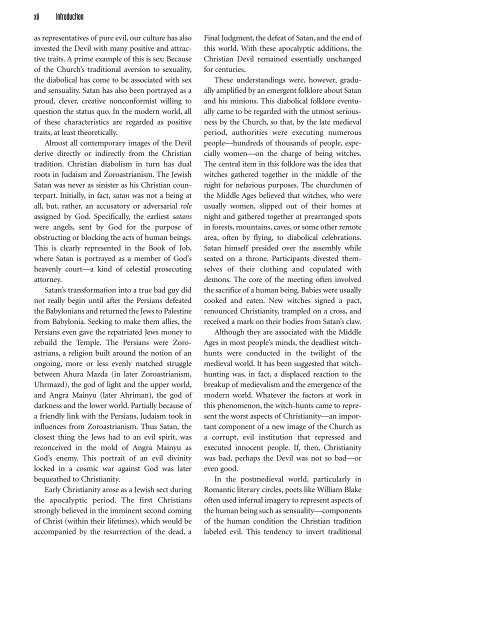Satanism Today - An Encyclopedia of Religion, Folklore and Popular ...
Satanism Today - An Encyclopedia of Religion, Folklore and Popular ...
Satanism Today - An Encyclopedia of Religion, Folklore and Popular ...
You also want an ePaper? Increase the reach of your titles
YUMPU automatically turns print PDFs into web optimized ePapers that Google loves.
xii<br />
Introduction<br />
as representatives <strong>of</strong> pure evil, our culture has also<br />
invested the Devil with many positive <strong>and</strong> attractive<br />
traits. A prime example <strong>of</strong> this is sex: Because<br />
<strong>of</strong> the Church’s traditional aversion to sexuality,<br />
the diabolical has come to be associated with sex<br />
<strong>and</strong> sensuality. Satan has also been portrayed as a<br />
proud, clever, creative nonconformist willing to<br />
question the status quo. In the modern world, all<br />
<strong>of</strong> these characteristics are regarded as positive<br />
traits, at least theoretically.<br />
Almost all contemporary images <strong>of</strong> the Devil<br />
derive directly or indirectly from the Christian<br />
tradition. Christian diabolism in turn has dual<br />
roots in Judaism <strong>and</strong> Zoroastrianism. The Jewish<br />
Satan was never as sinister as his Christian counterpart.<br />
Initially, in fact, satan was not a being at<br />
all, but, rather, an accusatory or adversarial role<br />
assigned by God. Specifically, the earliest satans<br />
were angels, sent by God for the purpose <strong>of</strong><br />
obstructing or blocking the acts <strong>of</strong> human beings.<br />
This is clearly represented in the Book <strong>of</strong> Job,<br />
where Satan is portrayed as a member <strong>of</strong> God’s<br />
heavenly court—a kind <strong>of</strong> celestial prosecuting<br />
attorney.<br />
Satan’s transformation into a true bad guy did<br />
not really begin until after the Persians defeated<br />
the Babylonians <strong>and</strong> returned the Jews to Palestine<br />
from Babylonia. Seeking to make them allies, the<br />
Persians even gave the repatriated Jews money to<br />
rebuild the Temple. The Persians were Zoroastrians,<br />
a religion built around the notion <strong>of</strong> an<br />
ongoing, more or less evenly matched struggle<br />
between Ahura Mazda (in later Zoroastrianism,<br />
Uhrmazd), the god <strong>of</strong> light <strong>and</strong> the upper world,<br />
<strong>and</strong> <strong>An</strong>gra Mainyu (later Ahriman), the god <strong>of</strong><br />
darkness <strong>and</strong> the lower world. Partially because <strong>of</strong><br />
a friendly link with the Persians, Judaism took in<br />
influences from Zoroastrianism. Thus Satan, the<br />
closest thing the Jews had to an evil spirit, was<br />
reconceived in the mold <strong>of</strong> <strong>An</strong>gra Mainyu as<br />
God’s enemy. This portrait <strong>of</strong> an evil divinity<br />
locked in a cosmic war against God was later<br />
bequeathed to Christianity.<br />
Early Christianity arose as a Jewish sect during<br />
the apocalyptic period. The first Christians<br />
strongly believed in the imminent second coming<br />
<strong>of</strong> Christ (within their lifetimes), which would be<br />
accompanied by the resurrection <strong>of</strong> the dead, a<br />
Final Judgment, the defeat <strong>of</strong> Satan, <strong>and</strong> the end <strong>of</strong><br />
this world. With these apocalyptic additions, the<br />
Christian Devil remained essentially unchanged<br />
for centuries.<br />
These underst<strong>and</strong>ings were, however, gradually<br />
amplified by an emergent folklore about Satan<br />
<strong>and</strong> his minions. This diabolical folklore eventually<br />
came to be regarded with the utmost seriousness<br />
by the Church, so that, by the late medieval<br />
period, authorities were executing numerous<br />
people—hundreds <strong>of</strong> thous<strong>and</strong>s <strong>of</strong> people, especially<br />
women—on the charge <strong>of</strong> being witches.<br />
The central item in this folklore was the idea that<br />
witches gathered together in the middle <strong>of</strong> the<br />
night for nefarious purposes. The churchmen <strong>of</strong><br />
the Middle Ages believed that witches, who were<br />
usually women, slipped out <strong>of</strong> their homes at<br />
night <strong>and</strong> gathered together at prearranged spots<br />
in forests, mountains, caves, or some other remote<br />
area, <strong>of</strong>ten by flying, to diabolical celebrations.<br />
Satan himself presided over the assembly while<br />
seated on a throne. Participants divested themselves<br />
<strong>of</strong> their clothing <strong>and</strong> copulated with<br />
demons. The core <strong>of</strong> the meeting <strong>of</strong>ten involved<br />
the sacrifice <strong>of</strong> a human being. Babies were usually<br />
cooked <strong>and</strong> eaten. New witches signed a pact,<br />
renounced Christianity, trampled on a cross, <strong>and</strong><br />
received a mark on their bodies from Satan’s claw.<br />
Although they are associated with the Middle<br />
Ages in most people’s minds, the deadliest witchhunts<br />
were conducted in the twilight <strong>of</strong> the<br />
medieval world. It has been suggested that witchhunting<br />
was, in fact, a displaced reaction to the<br />
breakup <strong>of</strong> medievalism <strong>and</strong> the emergence <strong>of</strong> the<br />
modern world. Whatever the factors at work in<br />
this phenomenon, the witch-hunts came to represent<br />
the worst aspects <strong>of</strong> Christianity—an important<br />
component <strong>of</strong> a new image <strong>of</strong> the Church as<br />
a corrupt, evil institution that repressed <strong>and</strong><br />
executed innocent people. If, then, Christianity<br />
was bad, perhaps the Devil was not so bad—or<br />
even good.<br />
In the postmedieval world, particularly in<br />
Romantic literary circles, poets like William Blake<br />
<strong>of</strong>ten used infernal imagery to represent aspects <strong>of</strong><br />
the human being such as sensuality—components<br />
<strong>of</strong> the human condition the Christian tradition<br />
labeled evil. This tendency to invert traditional
















